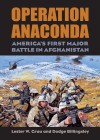Written by: Lester W Grau and Dodge Billingsley
University Press of Kansas, 2011, 464 pp,
ISBN 9780700618019
Reviewed by: WO2 Ian Kuring, Army History Unit
It is difficult to believe that almost a decade has passed since American and Allied forces (including Australian Special Forces) carried out their first major combat operation in Afghanistan. Operation ANACONDA was mounted against al-Qaeda and the Taliban in rugged mountain country around the Shar-i-Kot Valley near the Pakistan border during 2–15 March 2002.
Unknown to the Americans and their allies, the Shar-i- Kot Valley was defended by Taliban and al-Qaeda using prepared positions (including caves) located mostly on high ground and developed during the period from the Afghan-Soviet War. Allied intelligence did not identify that the enemy force was much larger than forecast and also promoted the expectation that the enemy would withdraw when confronted with the Allied force deployment. As a result the Allied forces’ scheme of manoeuvre for Operation ANACONDA was based on the hammer and anvil concept, with Afghan forces led by American Special Forces advancing to push the withdrawing enemy against Allied blocking forces (including elements from the 10th Mountain Division, 101st Airborne Division and various Allied Special Forces) in an effort to trap and destroy the enemy. In this case the enemy did not try to escape but used prepared defensive positions to stay and fight. The authors make the point very clearly that Operation ANACONDA was not an elegant, smooth operation and any consideration of success was due to the determination, perseverance and courage of the participants who adapted and overcame the operational and physical obstacles as well as the fog of war to inflict heavy casualties and logistic losses on a determined and well prepared enemy.
This book provides the reader with a detailed account of the whole operation, including the preparation and decision making and a blow by blow description of the fighting, concluding with a valuable chapter covering operational and tactical lessons learned. The book is easy to read with the complexity of the operation and combat made more understandable for the reader through the imaginative organisation of each chapter using subheadings incorporating location, event and timing backed up by formation/force identifying symbols. Throughout the book are specially prepared maps that show significant troop locations and movement as well as the terrain. It is a great pity that to keep the cost of the book to a reasonable price the maps were not printed in colour.
Included with the book is an excellent DVD which helps to set the scene for the events described in the book. For this reason I recommend that the reader views the DVD prior to reading the book. The DVD includes some great combat film as well as an interesting 15-minute conversational type explanatory discussion by the authors about the book and the making of the DVD.
The book Operation Anaconda by Les Grau and Dodge Billingsley is published by the University Press of Kansas and includes a DVD produced by Combat Films and Research. Even though Operation ANACONDA is comparatively well known (at least by name) most of what has been previously written focuses on battles involving the Special Forces, especially the tragic events on what has become known as Robert’s Ridge. These books include: Not A Good Day To Die by Sean Naylor, Roberts Ridge by Malcolm MacPherson, Shadow Wars by David Pugilese, Task Force Dagger by Robin Moore, and 18 Hours by Sandra Lee.
The author of the book is Dr Les Grau, a retired US Army Infantry Lieutenant Colonel and Vietnam veteran who is the research director for the Foreign Military Studies Office at the US Army’s Combined and General Staff College at Fort Leavenworth. He is a prolific researcher and writer of articles published in military journals and is the author of a number of books dealing with the Soviet military experience in Afghanistan—the best known being The Bear Went Over the Mountain. Les has visited Afghanistan on a number of occasions including walking the area where Operation ANACONDA took place.
The creator of the DVD is Dodge Billingsley, an award winning documentary filmmaker and the Director of Combat Films and Research Inc. He accompanied US Infantry soldiers into the Shar-i-Kot Valley during Operation ANACONDA and filmed their activities.
While Operation ANACONDA is covered in detail, scattered throughout the text Grau uses his knowledge and experience as a combat experienced infantry officer and military historian to provide the reader with insights and commentary about various aspects of modern combat as it affected operations in Afghanistan a decade ago. Topics covered include: helicopter operations in high altitude mountain country, the employment of night vision equipment, intelligence, air support, unity of command, organisation, long range fighting and the employment of infantry weapons, Army transformation, the support of competent subordinates, mountain warfare training, the soldiers load, changing key combat force elements during an operation, working with Allied forces, media relations, mobility, communications, and political objectives versus military objectives. None of these topics are new but their application to combat in Afghanistan in 2002 provided problems on the battlefield, even though they had been discussed and known about for decades.
The operational experience and lessons learned from Operation ANACONDA were used by the US Armed Forces to improve their military performance in subsequent operations in Iraq and continuing operations in Afghanistan.
This is a great book that can be read and studied by anyone (all military rank levels and military history enthusiasts) interested in modern combat operations involving land and air forces and the lessons that come from doing things for real, beyond the world of operational and tactical theory where discussion, planning, decision making, training and mission rehearsal exercises point toward perfect results.

